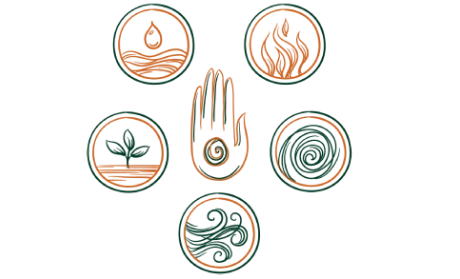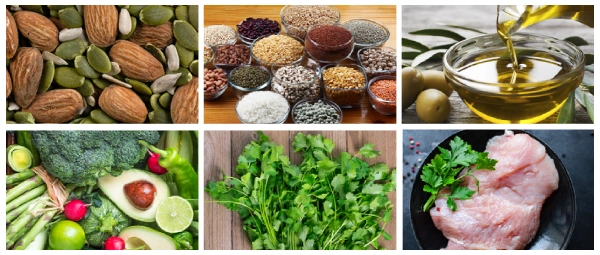Pitta originates from the root word ‘tapa’, which means ‘heat.’ Pitta is made up of the two vital life elements of “Agni” or “fire” and “Jala” or “Water” which are part of 5 life elements Space (Aakash), Air (Vayu), Fire (Agni), Water (Jala), and Earth (Prithvi) according to Ayurveda.
Pitta due to its fluid nature aids in the functioning of digestion which influences the metabolism and changes in the body.
Pitta Dosha which is concerned with the “Agni”, or the digestive power of the body helps to manage the digestive system and ensures its proper functioning to avoid any stomach-related ailments.
Summer is known as pitta season.
It is also known to govern body temperature, visual perception, skin color and complexion, intelligence, and emotions.
People with Pitta Prakriti or constitutional character are forceful, intense, and restless by nature; they like to be leaders, planners and seek material prosperity.
According to Ashtanga Hrdayam, an important Ayurvedic scripture Pitta is subdivided into five types:
1. Pachaka: This pitta is known to govern digestion and absorption of food.
2. Ranjaka: This pitta is responsible for the color of the blood and governs the proper functions of blood.
3. Sadhaka: This pitta is placed in the brain and heart and is associated with maintaining intelligence (ahamkara) and emotional balance during times of intense stress
4. Bhrajaka: This Pitta is responsible for the appropriate color (melanin) of the skin, hair, and all other auxiliary tissues. It controls the sweat and sebum glands.
5. Alochaka: Governs the vision and its associated centers in the Brain.
Common characteristics of Pitta Dosha

Pitta dominant people tend to have a medium physique, a lot of stamina, and strong muscles. They usually have freckled skin and can easily become red or inflamed in the sun. When Pitta is out of balance, they become easily agitated and aggressive and are prone to hate, rage, and jealousy
They have a good digestive system and a strong appetite. They tend to become irritable and grumpy if they do not eat on time. They are prone to health issues such as inflammation, rashes, acne, and irritable bowel syndrome.
Here are some common characteristics of Pitta dominated person:
| Type/Features | Common Traits |
|---|---|
| Body Feature | Medium body structure and often strong physique. |
| Skin | Oily skin, inflammation, easy sunburns, freckles, acne-prone. |
| Hair | Tend to have straight hair, premature greying. |
| Weight | It is easy to gain and easy to lose weight. |
| Strengths | Smart, purposeful, quick learner, self-motivated, strong drive for success, natural leaders |
| Weaknesses | Irritable, prone to dispute, foodie, often feel mood swings, sensitive to warm temperature. |
| Food Preference | Prefer sweet and bitter flavors. |
| Speech | Expressive, decisive, clear, sharp tone. |
To know your Dosha type, take our comprehensive Dosha quiz today!
Signs of a Pitta Imbalance
Pitta is considered to have properties such as Hot, Light, Intense, Penetrating, Pungent, and Sharp, and excess of any of these traits can aggravate pitta
When out of balance, people with Pitta tend to become very agitated and short-tempered.
Here are some common disorders caused due to Pitta imbalance:
- Acid reflux and Constipation
- Renal and Kidney Infections
- Hyperthyroidism
- Jaundice
- Arthritis
- Diarrhea
- Depression
- Insomnia
- OCD or obsessive-compulsive disorder
- Migraines with vertigo
- Strokes
- Chronic fatigue
- Acne and Eczema
- Dermatitis
- Peptic ulcers
- Poor vision or blindness
- Excessive hair fall or baldness
- Unbalanced hormones
- Body odor and bad breath
- Heavy menstrual bleeding

Diet to pacify Pitta Imbalance
Pitta-balancing foods are generally sweet, bitter, and sour in flavor. Ayurveda considers these flavors to be cooling, drying, and soothing for excess pitta.
For healthy digestion, all six tastes (sweet, sour, salty, pungent, bitter, and astringent) are advised.

Here are some insights on the dietary regimes to ease Pitta Dosha:
| Category | Foods to Eat | Foods to Avoid |
|---|---|---|
| Vegetables | Pumpkins, broccoli, asparagus, lettuce, green beans, cucumbers, potatoes, sweet potatoes, green leafy vegetables, cauliflower, celery, okra, and zucchini. | Tomatoes, onions, garlic, hot peppers, carrots, beets, eggplant, radishes, and spinach. |
| Fruits | Oranges, grapes, melons, coconuts, avocados, mangoes, pomegranates, cherries, pineapples, and plums. | Grapefruits, apricots, kiwi, cranberry, and other berries. |
| Spices | Coriander, cilantro, cardamom, mint, saffron, and fennel | Black pepper, ginger, cumin, fenugreek, clove, and mustard seed |
| Grains | Wheat, rice, Black beans, mung dal, kidney beans, chickpeas, split peas, soya beans, couscous, granola, quinoa, barley, and oats | Millet, corn, urad dal, buckwheat, rye, and brown rice. |
| Nuts | Flaxseeds, almonds (soaked & peeled), pumpkin seeds, and sunflower seeds. | Cashew, almonds with skin, walnuts, sesame seeds, pecans, pistachios, tahini, chia seeds, and peanuts |
| Oils | Olive oil, ghee, coconut oil, and sunflower oil | Sesame oil, almond oil, and corn oil |
| Others | Chicken, turkey, cow’s milk, cottage cheese, and goat’s cheese | Eggs, beef, pork, salmon, seafood, Salted butter, buttermilk, frozen yogurt, and sour cream |
Tips to balance Pitta Dosha

Pitta doshas should prioritize work-life balance and avoid extreme heat (be it hot weather or spicy food). Pitta dominant individuals must identify and regulate their powerful urges and try to redirect them in more productive ways and learn to create a balance.
Adopting a regular healthy lifestyle that is in sync with nature’s cycles is one of the most significant changes that support good health in Pitta dominant people.
Here are a few tips that will help you manage your Pitta Dosha:
- Spend some time in nature.
- Try meditation on a daily basis.
- Avoid being awake after 10 p.m.
- Find a balance between activity and rest.
- Lunch should be the biggest meal of the day.
- Listen to sweet and soothing music to keep calm.
- Incorporate yoga asanas and pranayama in daily routine.
- Inculcate a habit for oil massage or abhyanga, once a week.
- Try Epsom salt baths infused with herbs like lavender and rose.
Our lives, surroundings, and health change on a daily basis. It is important to be updated with the changes and how they affect us.
We recommend you to take our Ayurveda dosha quiz to assess how things are changed with time and make the necessary changes needed to restore balance.





Do you want to learn more? Ask us! OR Do you know more about this topic? Educate us.